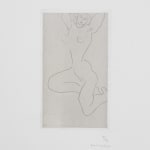Henri Matisse
Further images
In the delicate etching ‘Nu assis sur la jambe droite, bras levés,’ Henri Matisse captures the ephemeral nature of human grace with a sparing economy of line that speaks volumes. Completed in 1931, this etching on Chine appliqué on Arches Velin paper is part of a series Matisse worked on from 1926 to 1931, where he elaborated on the essential forms and postures of reclining nudes and intimate portraits. The series marks a profound period of Matisse's exploration into printmaking, where he translated his masterful skills as draughtsman into the distinct vernacular qualities and processes of etching. In this work, the nude figure is both a culmination of studied observation and a spontaneous lyrical gesture—a duality that Matisse navigated with adept skill, creating a work that is as much an expression of form as it is an invocation of the artist's silent dialogue with his subject.
Matisse's foray into the realm of printmaking extended his exploration as a draughtsman into a new dimension, one where the interplay of light and shadow, presence and absence became more pronounced. The present work exemplifies this extension, with its lines flowing unerringly to delineate form, revealing an intimate understanding of the human body's contours and the subtlety of its movements. The artist's hand is evident in each trace, a testament to Jay McKean Fisher's observation: “Printmaking was Matisse’s primary means of demonstrating to his audience his working process, the character of his vision, and the way his drawing transformed what he observed.” This statement underscores the work's inherent narrative, not merely of the subject portrayed but of the very act of its creation.
In clear contrast to the vivid hues that characterized his Fauvist period, Matisse’s black and white prints, such as ‘Nu assis sur la jambe droite, bras levés,’ offer a complementary perspective on his artistic practice. These works strip away the sensory seduction of color, compelling the viewer to engage with form, volume, and the essential qualities of line. Through this reductive process, Matisse reveals the structural and emotive underpinnings of his art, presenting a raw and potent vision that is as revealing as any of his more chromatically adventurous works. Other proofs of this important etching are housed in the esteemed collections of the Baltimore Museum of Art, Maryland, The Blanton Museum of Art of The University of Texas at Austin, the Bibliothèque littéraire Jacques Doucet, Paris, and the Bibliothèque Nationale de France, Paris.
NOTES
This artwork is signed and numbered in pencil, from the edition of 25.
Image: 4 5/8 x 2 3/4 in (11.8 x 7 cm)
Paper: 14 3/4 x 11 1/4 in (37.5 x 28.5 cm)
Provenance
The artistPierre Matisse, New York (acquired from the above)
Pierre-Noël Matisse, New York (the artist's grandson; acquired from the above)
The estate of Jacquelyn Miller Matisse
Christie's New York, Matisse on Paper, June 23, 2021, lot 16
Private collection, New York






